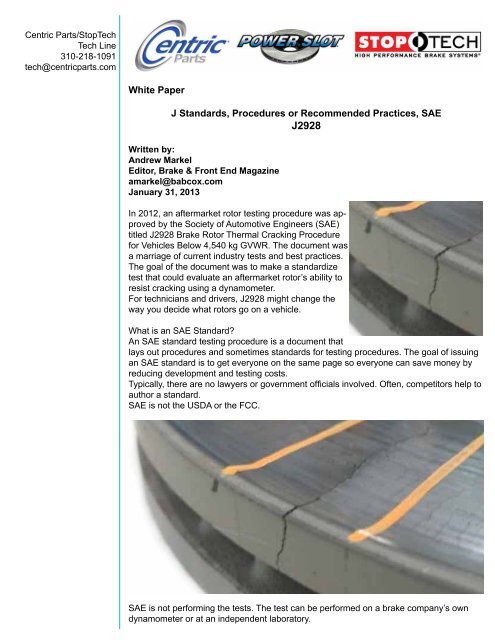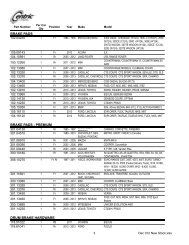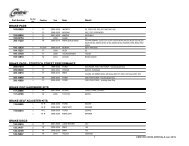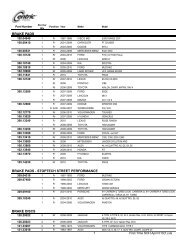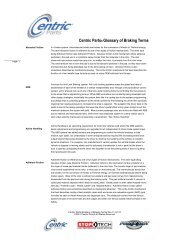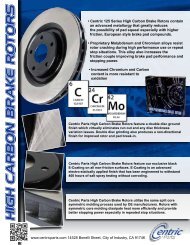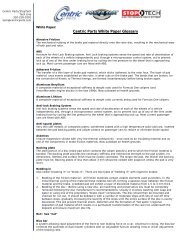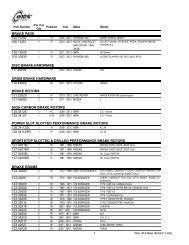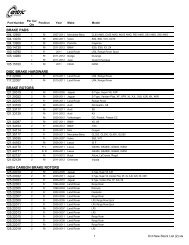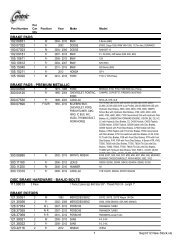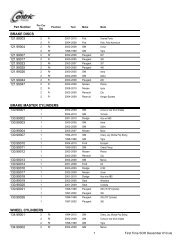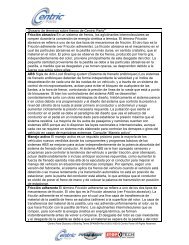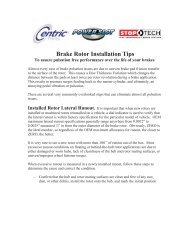J2928 Rotor Thermal Cracking Test Procedure - Centric Parts
J2928 Rotor Thermal Cracking Test Procedure - Centric Parts
J2928 Rotor Thermal Cracking Test Procedure - Centric Parts
You also want an ePaper? Increase the reach of your titles
YUMPU automatically turns print PDFs into web optimized ePapers that Google loves.
<strong>Centric</strong> <strong>Parts</strong>/StopTech<br />
Tech Line<br />
310-218-1091<br />
tech@centricparts.com<br />
White Paper<br />
J Standards, <strong>Procedure</strong>s or Recommended Practices, SAE<br />
<strong>J2928</strong><br />
Written by:<br />
Andrew Markel<br />
Editor, Brake & Front End Magazine<br />
amarkel@babcox.com<br />
January 31, 2013<br />
In 2012, an aftermarket rotor testing procedure was approved<br />
by the Society of Automotive Engineers (SAE)<br />
titled <strong>J2928</strong> Brake <strong>Rotor</strong> <strong>Thermal</strong> <strong>Cracking</strong> <strong>Procedure</strong><br />
for Vehicles Below 4,540 kg GVWR. The document was<br />
a marriage of current industry tests and best practices.<br />
The goal of the document was to make a standardize<br />
test that could evaluate an aftermarket rotor’s ability to<br />
resist cracking using a dynamometer.<br />
For technicians and drivers, <strong>J2928</strong> might change the<br />
way you decide what rotors go on a vehicle.<br />
What is an SAE Standard?<br />
An SAE standard testing procedure is a document that<br />
lays out procedures and sometimes standards for testing procedures. The goal of issuing<br />
an SAE standard is to get everyone on the same page so everyone can save money by<br />
reducing development and testing costs.<br />
Typically, there are no lawyers or government officials involved. Often, competitors help to<br />
author a standard.<br />
SAE is not the USDA or the FCC.<br />
SAE is not performing the tests. The test can be performed on a brake company’s own<br />
dynamometer or at an independent laboratory.
<strong>Centric</strong> <strong>Parts</strong>/StopTech<br />
Tech Line<br />
310-218-1091<br />
tech@centricparts.com<br />
White Paper<br />
J Standards, <strong>Procedure</strong>s or Recommended Practices, SAE<br />
<strong>J2928</strong><br />
The <strong>Test</strong><br />
SAE <strong>J2928</strong> test procedures subjects a rotor to 150 heat cycles. A heat cycle is when a rotor<br />
is cold and brought to a high temperature. During a heat cycle, a rotor will expand and<br />
contract. This can create fatigue in a rotor that can cause cracking and structural failure.<br />
During the 150 heat cycles, the rotor is inspected; this includes dimensions and a inspection<br />
for damage.<br />
The objective of the test is to thermally and mechanically stress the rotor so any deficiencies<br />
in the metallurgy or structure are exposed. <strong>J2928</strong> also covers how to document and<br />
classify cracks.<br />
Unlike a USDA grade or a PG movie rating, SAE <strong>J2928</strong> is just a document and procedures.<br />
It is up to the industry to adopt and embrace these tests. It can help the supply<br />
chain to compare and evaluate rotor manufacturers. It can add consistency and accountability<br />
to the supply chain. This will benefit shops directly.
<strong>Centric</strong> <strong>Parts</strong>/StopTech<br />
Tech Line<br />
310-218-1091<br />
tech@centricparts.com<br />
White Paper<br />
J Standards, <strong>Procedure</strong>s or Recommended Practices, SAE<br />
<strong>J2928</strong><br />
The Marketing of <strong>J2928</strong><br />
Chances are you will never get your hands on a SAE <strong>J2928</strong> report. But, you may have<br />
to deal with a supplier or manufacture using <strong>J2928</strong> to sell you a brake rotor. This could be<br />
where some marketing departments and field reps could get themselves in trouble.<br />
No one can claim their rotors are SAE <strong>J2928</strong> certified. No rotor manufacturer can make<br />
the claim that by being able to pass the 150 stops that their rotors stop sooner, make less<br />
noise or last longer. <strong>J2928</strong> does not test for this. Nor can a manufacturer make the claim<br />
that since their rotors are tested with <strong>J2928</strong> that they meet a government standard set<br />
forth by DOT or NHTSA.<br />
What a rotor manufacturer can claim is that their rotors were tested using the SAE <strong>J2928</strong><br />
and assessed using accepted industry performance criteria. Or, their rotors meet industryaccepted<br />
pass/fail criteria regarding number of cycles without severe cracks.<br />
Bottom Line<br />
SAE <strong>J2928</strong> is a step forward because it helps everyone in the supply chain speak the<br />
same language and it sets criteria when it comes to measuring aftermarket rotors.
<strong>Centric</strong> <strong>Parts</strong>/StopTech<br />
Tech Line<br />
310-218-1091<br />
tech@centricparts.com<br />
White Paper<br />
J Standards, <strong>Procedure</strong>s or Recommended Practices, SAE<br />
<strong>J2928</strong><br />
What SAE 2928 is:<br />
• An aftermarket rotor testing procedure.<br />
• A series of 150 heat cycles performed on a dynamometer.<br />
• The test procedure measures the thermal and structural adequacy of a rotor<br />
• A method of measuring, classifying and documenting cracks in the rotor.<br />
• A tool for supply chain to perform quality control on the products it sells.<br />
• A way to compare an aftermarket rotor to the OE rotor.<br />
• It measures rotors for runout and thickness variation.<br />
• It does specify a rotor must meet a percentage of the original rotor’s weight<br />
• It does specify a rotor must be within certain dimensional tolerances.<br />
What SAE 2928 is not:<br />
• A way to police bad rotors.<br />
• It is not mandatory for all manufacturers including OEMs.<br />
• It does not measure on-vehicle performance or stopping distances.<br />
• It does not measure noise or durability.<br />
• It does not “certify” or “approve” a rotor.<br />
• It is not performed on a vehicle<br />
• It does not determine the design of the rotors fins.<br />
Photos Courtesy of SAE


